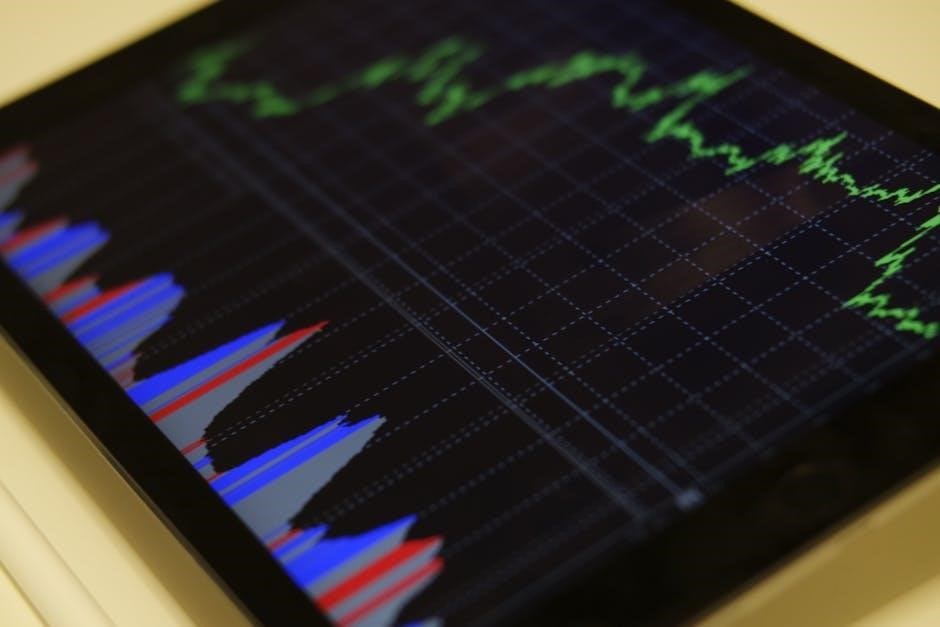
Trading Chart Patterns PDF: A Comprehensive Guide
Trading chart patterns offer visual representations of price movements‚ aiding traders in identifying potential trends and making informed decisions. This comprehensive guide explores the fascinating realm of trading chart patterns‚ unraveling secrets within price charts‚ thereby guiding traders toward success.
Chart patterns are a cornerstone of technical analysis‚ assisting traders in anticipating future price movements based on historical trends. They represent visual formations on price charts that suggest potential future price movements. Traders utilize these patterns to pinpoint possible entry and exit points in the market‚ enhancing their trading decisions.
These patterns are essentially combinations of trend lines measured by price action. Recognizing chart patterns involves identifying shapes like triangles‚ rectangles‚ and wedges‚ which signal potential continuations‚ reversals‚ or bilateral movements. Chart patterns help traders understand the dynamics of supply and demand‚ giving insights into market sentiment.
Technical analysts employ chart patterns to exploit market trends by identifying these formations. They are classified into continuation‚ reversal‚ and bilateral categories‚ indicating whether a trend will persist‚ change direction‚ or move either way. Mastering chart patterns is essential for any trader seeking to improve their analytical skills and trading strategies.
Understanding Technical Analysis Basics
Technical analysis is a method used to forecast the direction of prices through the study of past market data‚ primarily price and volume. It relies on the assumption that market prices reflect all available information‚ and historical price movements can indicate future trends. Technical analysis is a crucial skill for traders‚ helping them to make informed decisions by examining charts and indicators.
At the heart of technical analysis are concepts like trends‚ support and resistance levels‚ and volume analysis. Trends identify the general direction of the market‚ while support and resistance levels indicate price points where the market is likely to find buying or selling pressure. Volume analysis helps confirm the strength of a trend or potential reversals.

Technical analysis also involves the use of various tools such as moving averages‚ oscillators‚ and chart patterns. Moving averages smooth out price data to identify trends‚ while oscillators measure the momentum of price movements. Chart patterns provide visual representations of price behavior‚ helping traders to anticipate potential market moves based on historical data.
Types of Chart Patterns: Reversal Patterns
Reversal patterns are key formations in chart analysis that signal a potential change in the prevailing trend. These patterns are essential for traders looking to capitalize on trend reversals and manage risk effectively. Identifying reversal patterns early can provide opportunities to enter trades at favorable prices and exit before the trend resumes its original direction.
Common reversal patterns include the head and shoulders‚ inverse head and shoulders‚ double top‚ and double bottom. The head and shoulders pattern indicates a bearish reversal‚ while the inverse head and shoulders suggests a bullish reversal. Double tops and bottoms are also significant reversal patterns that signal the end of a trend.
Reversal patterns form after an extended trend and often involve a period of consolidation or sideways movement before the actual reversal occurs. Traders use volume analysis and other technical indicators to confirm the validity of these patterns. Recognizing and understanding reversal patterns is crucial for making informed trading decisions and improving overall profitability.
Types of Chart Patterns: Continuation Patterns
Continuation patterns are formations on price charts that suggest the current trend will likely persist. These patterns offer traders opportunities to enter or add to existing positions‚ capitalizing on the ongoing momentum. Identifying continuation patterns can help confirm the strength of a trend and provide clear entry and exit points.
Common continuation patterns include flags‚ pennants‚ and triangles. Flags and pennants are short-term consolidation patterns that form after a sharp price movement‚ indicating a brief pause before the trend resumes. Triangles‚ such as ascending‚ descending‚ and symmetrical triangles‚ also signal a continuation of the trend‚ with the price expected to break out in the direction of the existing trend.
Traders often use volume analysis to confirm continuation patterns‚ looking for increased volume during the breakout. Continuation patterns are valuable tools for traders as they provide clear signals and can be used in various timeframes. Understanding and recognizing these patterns can significantly enhance a trader’s ability to profit from trending markets.
Types of Chart Patterns: Bilateral Patterns
Bilateral patterns are chart formations that indicate the price could move in either direction‚ making them more complex to trade than reversal or continuation patterns. These patterns signify a period of indecision in the market‚ where neither buyers nor sellers have a clear advantage‚ leading to potential volatility.
A common example of a bilateral pattern is the symmetrical triangle. In this pattern‚ the price consolidates within converging trendlines‚ indicating uncertainty. A breakout can occur in either direction‚ making it crucial for traders to wait for confirmation before taking a position. Volume often decreases during the formation of the triangle and then increases significantly upon the breakout‚ providing additional confirmation.
Trading bilateral patterns requires patience and careful analysis. Traders should watch for a decisive break above or below the triangle’s trendlines before entering a trade. Setting appropriate stop-loss orders is essential to manage risk‚ as the price movement can be unpredictable. Successfully trading bilateral patterns can be rewarding‚ but it demands a cautious and well-planned approach.
Key Chart Patterns for Day Trading
Day trading demands quick decision-making and the ability to identify short-term trends. Certain chart patterns are particularly useful for day traders due to their frequent occurrence and clear signals. These patterns can provide valuable insights into potential price movements within a single trading day.
One such pattern is the flag pattern‚ which signals a brief pause in a strong trend. Bullish flags appear in uptrends‚ while bearish flags occur in downtrends. Day traders look for breakouts from these flags to capitalize on the continuation of the prevailing trend. Another important pattern is the triangle‚ which can be ascending‚ descending‚ or symmetrical. Ascending triangles are generally bullish‚ descending triangles are bearish‚ and symmetrical triangles indicate potential breakouts in either direction.
Additionally‚ candlestick patterns like the hammer‚ shooting star‚ and engulfing patterns provide rapid signals for potential reversals. Day traders often combine these candlestick patterns with broader chart patterns to enhance their trading strategies. Effective use of these patterns requires practice and a keen understanding of market dynamics.
Identifying Chart Patterns on Forex Charts
Forex charts are essential tools for traders‚ acting as roadmaps to spot trends and potential opportunities in currency markets. Identifying chart patterns on these charts is crucial for making informed trading decisions. Chart patterns are visual representations of price movements that help traders understand market dynamics and anticipate future price actions.
Several key chart patterns are particularly useful in forex trading. Head and Shoulders patterns indicate potential trend reversals‚ with the “head” representing a peak and the “shoulders” representing smaller peaks on either side. Double Tops and Double Bottoms also signal reversals‚ showing where price attempts to break a level failed twice. Continuation patterns like flags‚ pennants‚ and triangles suggest that the current trend will likely continue.
To effectively identify these patterns‚ traders need to analyze price charts across different time frames. Understanding the psychology behind each pattern is also important. For example‚ a symmetrical triangle indicates a period of indecision before a breakout. Combining pattern recognition with other technical indicators can enhance the accuracy of trading signals‚ ultimately improving trading outcomes.
Utilizing Chart Patterns for Intraday Trading
Intraday trading‚ characterized by short-term strategies‚ benefits significantly from the use of chart patterns. These patterns provide quick insights into potential price movements‚ enabling traders to make rapid decisions. Chart patterns in intraday trading serve as visual cues‚ helping traders understand the immediate dynamics of supply and demand.
Common intraday chart patterns include flags‚ pennants‚ and triangles‚ which often signal continuation of existing trends. Reversal patterns like head and shoulders or double tops/bottoms can also appear on shorter time frames‚ indicating potential shifts in market direction. Identifying these patterns requires a keen eye and quick analytical skills. Traders must be adept at recognizing patterns as they form‚ allowing them to capitalize on fleeting opportunities.
Effective utilization involves combining chart pattern recognition with other technical indicators‚ such as volume and moving averages‚ to confirm signals. Risk management is paramount; setting tight stop-loss orders is essential to protect capital in volatile intraday environments. Successful intraday traders use chart patterns as part of a comprehensive strategy‚ incorporating both technical analysis and disciplined risk control.
Incorporating Candlestick Patterns
Candlestick patterns are invaluable tools for traders‚ offering insights into market sentiment and potential price movements. Integrating candlestick patterns with traditional chart patterns enhances the accuracy and reliability of trading signals. Candlesticks provide a detailed view of price action within a specific time frame‚ showing the open‚ high‚ low‚ and close prices.
Common candlestick patterns include bullish engulfing‚ bearish engulfing‚ hammer‚ and shooting star‚ each signaling potential reversals or continuations. When these patterns align with chart patterns‚ they create a powerful confluence‚ strengthening the conviction of a trading decision. For example‚ a bullish engulfing pattern appearing at the bottom of a double bottom chart pattern can confirm a potential upward reversal.
Effective integration requires understanding both individual candlestick patterns and how they interact with larger chart formations. Traders should look for candlestick patterns that validate the signals generated by chart patterns‚ increasing the probability of successful trades. Combining these techniques allows traders to gain a more nuanced understanding of market dynamics and improve their overall trading performance. Risk management remains crucial‚ with stop-loss orders placed strategically based on the combined signals.
Time Frame Considerations for Pattern Trading
The selection of an appropriate time frame is critical in pattern trading‚ significantly influencing the effectiveness of chart patterns. Different time frames reveal varying levels of market detail‚ impacting the identification and interpretation of patterns. Short-term traders‚ such as day traders‚ often focus on intraday charts like 5-minute‚ 15-minute‚ or hourly charts to capture quick price movements.
Swing traders may prefer daily or weekly charts to identify trends lasting several days or weeks. Long-term investors typically analyze monthly or yearly charts to understand broader market trends. The reliability of a chart pattern can vary depending on the time frame; patterns on longer time frames generally carry more weight.

It is essential to align the time frame with your trading style and objectives. Confirming patterns across multiple time frames can also enhance the robustness of trading signals. For instance‚ a pattern identified on a daily chart can be validated by observing similar formations on weekly or monthly charts. This multi-time frame analysis provides a more comprehensive view of market dynamics‚ improving the accuracy of trading decisions and reducing the risk of false signals.
Best Practices and Tips for Trading Chart Patterns
To excel in trading chart patterns‚ adopt several best practices. Firstly‚ always confirm patterns with additional technical indicators like volume or moving averages to enhance signal reliability. Avoid relying solely on visual identification; instead‚ use concrete rules for entry‚ stop-loss‚ and profit targets.
Secondly‚ manage risk diligently by setting appropriate position sizes and stop-loss orders. Recognize that chart patterns are not foolproof‚ and unexpected market events can invalidate them. Thirdly‚ practice patience and discipline. Not every pattern will lead to a successful trade‚ so avoid forcing trades that don’t meet your criteria.

Fourthly‚ continuously educate yourself on different patterns and market conditions‚ refining your understanding and adapting your strategies. Utilize chart pattern cheat sheets and PDF guides to refresh your knowledge. Lastly‚ keep a trading journal to track your trades‚ analyze your performance‚ and identify areas for improvement. By following these best practices and remaining adaptable‚ you can significantly improve your success in trading chart patterns. Remember‚ consistent learning and disciplined execution are key to long-term profitability.
